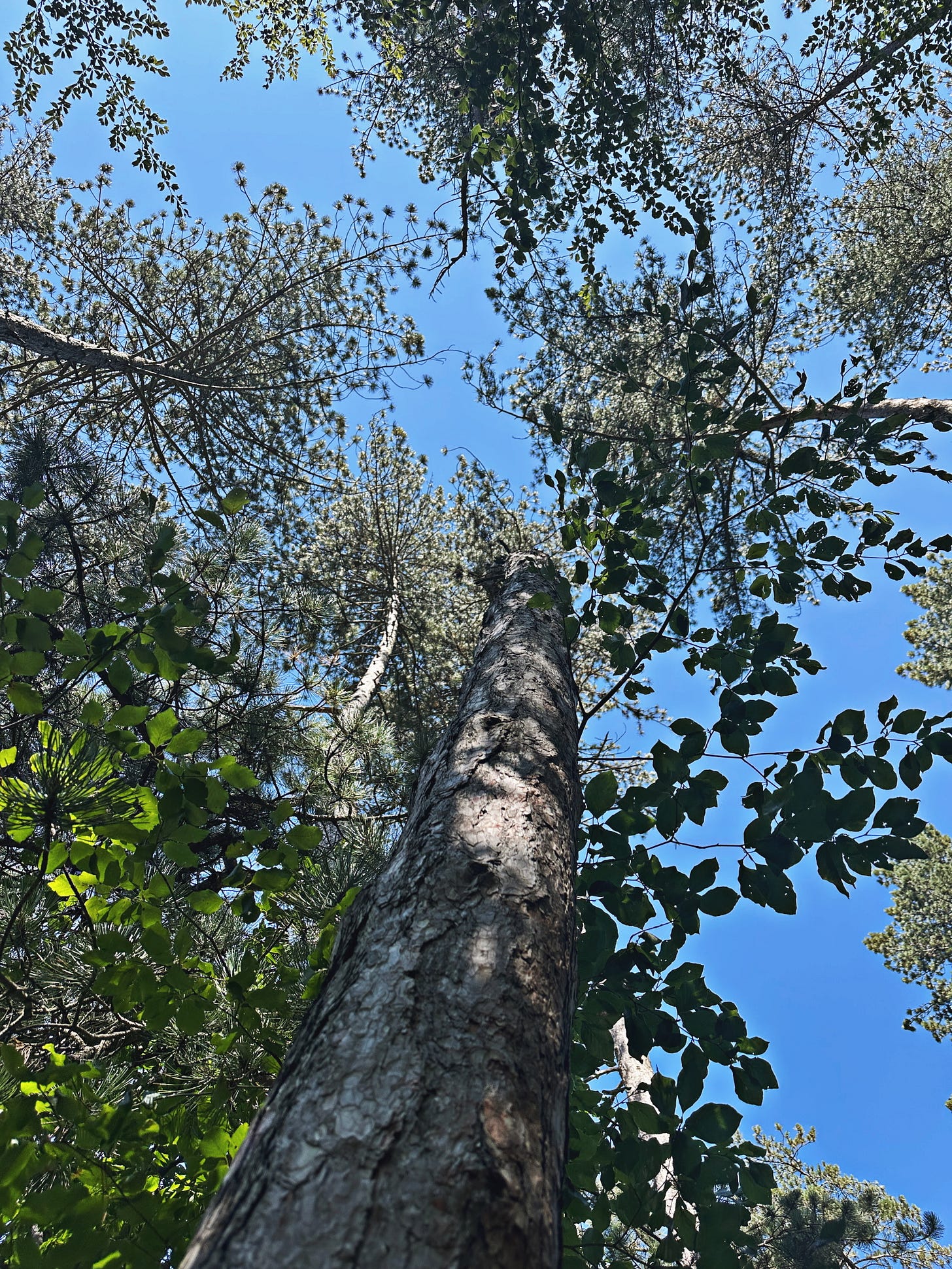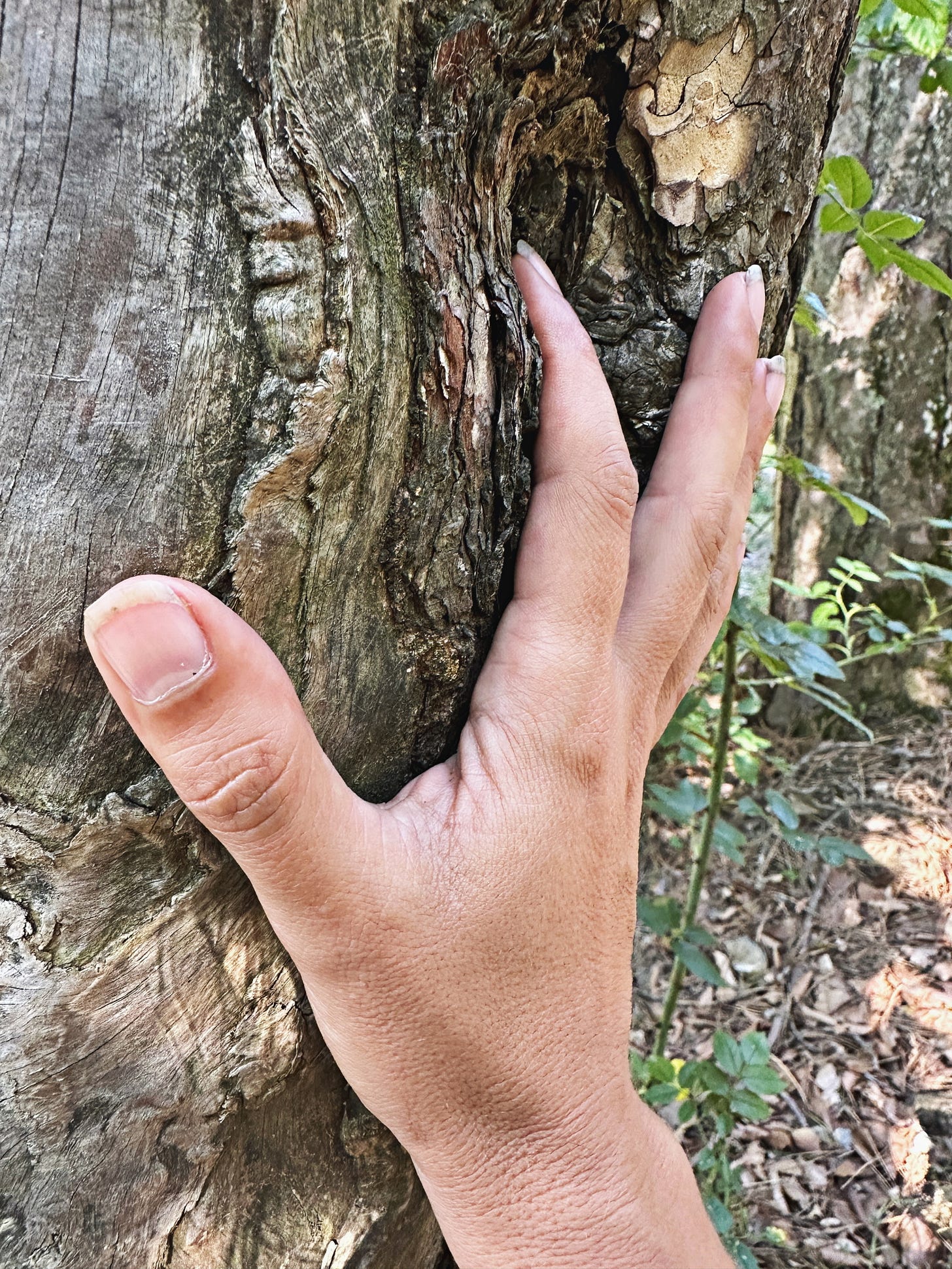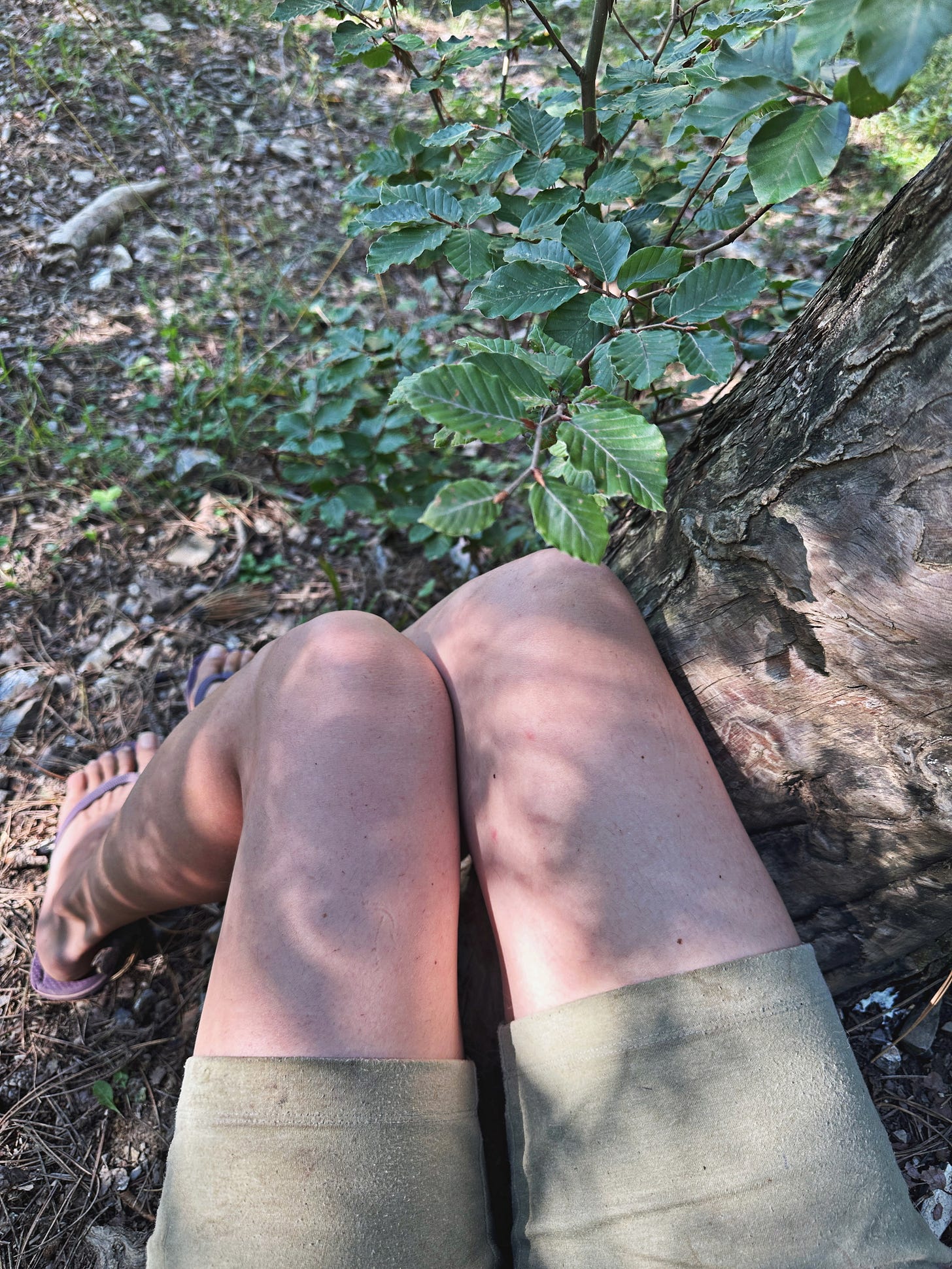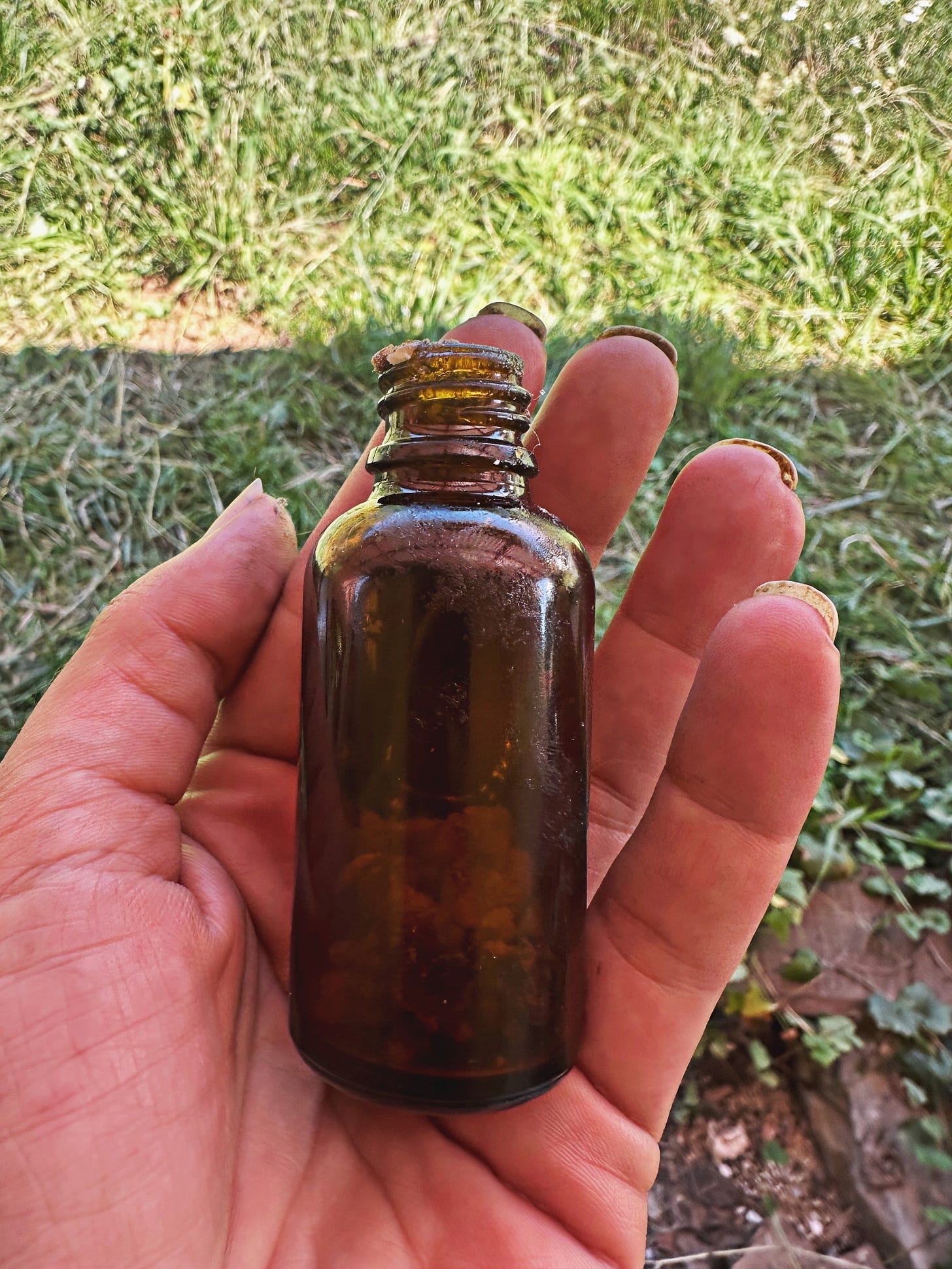The Call Of The Pine Tree
Under The Spell Of A Full Moon
Even though the majority of the forests here in the valley consist of beech and oak, right behind my house, on the very edge, it starts with pine. On hot days like these their scent is irresistable, alluring, intoxicating. Flicking through the freshly written pages of my healing journal, I suddenly closed my eyes, as a particularly strong whiff crept into my nose. It made me restless.
After ignoring the rather loud lure for a few minutes, trying to force myself to focus on my meditation and writing, I got up. I swapped my flimsy flip flops for some sturdier footwear, made sure puss Puk was safe in the house (at the moment I cannot risk her following me outside of the courtyard as there are foxes, stray dogs and unfriendly neighbour dogs), and I set off.
As the backyard is fully surrendered to giant weeds, except for a narrow path to the outhouse, I took the outside way around. The path leads upward, and even though the slope isn’t that steep, I struggled with my breathing. This asthma type of shortness of breath started last winter, making me think that the bout of flu may have actually been a new COVID strand. I dare not think this diminished breathing capacity has anything to do with my mystery mass (I am exploring gentle breath work). Either way, I have become capable of experiencing it, giving it the time it needs to settle. I don’t panic. I don’t push through.
Once I reach the row of pines, one in particular catches my eye. The closer I come the stronger she feels, even though she is the slimmest of the bunch. Suddenly I feel myself collapsing into her, into an embrace. It happens so fast, that at first I don’t realise there is a rosehip bush right behind her, to which I am now also holding on a little too tight. The thorns pierce the soft and supple skin of the inside of my arms.
I cry. Not the silent tears, but a loud cry that stems from deep within the burrows of my belly. I don’t know why. Sure, there is an endless list of topics to shed my tears on, ranging from the personal and intimate to the global and universal. We do all seem to be in dire straits these days.
I look up. Oh, I love you, I say, but I don’t know really who you are.
IDENTIFYING THE SPECIES
This is not my forte. I lack the ground work in botany. As easy as it is for me to be in communion with all that is alive, the harder it is for me to “study” any sentient being*.
After rummaging around on internet, I learn what to look for:
The bark is flaky with reddish-brown and grey patches, not deeply furrowed like older black pines, and without the strong orange plates of Scots pine on the upper trunk.
The needles appear to be bundled in twos (if you look closely at the bases) and they’re very long (around 15–20 cm or more).
Those two traits together point strongly to Austrian Pine / European Black Pine (Pinus nigra). This is a common species found in Romania’s mountain and sub-mountain zones.
(Valea Zalanului is situated in the Baraolt mountains of Transylvania. It has the so-called humid continental climate (Koppen Geiger Dfb). Climate change must be affecting us here too, as winters are less fierce and summers are heating up. Drought is also bringing new challenges, with well drying up and growing crops challenged by either late sudden frost or sudden bursts of heat. My neighbour’s apricot trees did not bear a single fruit this season.)
SPEAKING TO THE SOUL OF THE TREE
Core symbolic themes that I found:
Resilience and longevity
Black pine can live for several centuries, with some specimens over 500 years old. In symbolism, that endurance becomes a metaphor for inner strength, persistence through adversity, and the ability to withstand harsh conditions without losing vitality.Protection and guardianship
Because black pines often grow on exposed slopes and windy ridges, they are seen as guardians of the land, holding soil in place and providing shelter. This has translated into a symbolic role as a protector of boundaries, both physical and spiritual.Purification and renewal
In various European folk traditions, pine resin and needles have been used for cleansing spaces and warding off illness. Black pine, in particular, with its strong resin scent, becomes a symbol of clearing away stagnation and restoring fresh energy.Rootedness with flexibility
Its deep roots anchor it in rocky soil, yet the branches bend in strong winds. This balance often appears in spiritual symbolism as the ability to stay grounded while adapting to change.Bridge between realms
In some Alpine and Balkan folk beliefs, tall pines are considered connectors between earth and sky, carrying prayers upward. Black pine’s towering height and dark, striking crown make it especially suited to this imagery.
Regional associations
In Japan, where a related species is cultivated, black pines are symbols of dignity, steadfast friendship, and the quiet strength of age.
In Central Europe, black pine groves have been considered places of both healing and solemn reflection. Some traditional healers would collect needles or resin under specific moon phases for protective charms.
In Romanian and broader Carpathian folk tradition, Pinus nigra carries a mix of practical, healing, and spiritual meanings:
Tree of endurance
Mountain people saw black pine as a tree that survives where others cannot — on wind-beaten ridges, in thin soil, under heavy snow. Hugging it was sometimes spoken of as “borrowing its spine” when you needed courage or stamina.Protector against “stricătura”
In some rural beliefs, black pine resin was burned or worn to ward off the deochi (evil eye) and stricătura (malicious harm or withering energy). Standing with your back to the trunk was thought to draw away the weakness.Healing tree
Infusions of the needles or resin-infused oil were used for chest complaints, winter coughs, and joint pain. The act of gathering from the tree respectfully — speaking to it, leaving an offering — was part of the healing ritual.Link to mountain spirits
In old shepherd lore, the highest pines on the ridges were “singing posts” where wind carried prayers and messages to the moșii muntelui — ancestral spirits of the mountain. A solitary black pine was never cut without ceremony, as it was thought to guard the place.Seasonal marker
Black pines were green all year, a living sign in the bleak midwinter that life persisted. Branches were sometimes brought into homes not just at Christmas but at other thresholds, like before a wedding or after a birth, to invite strong, enduring energy.
TAKING HER HOME WITH ME FOR MEDITATION
I run back to the house and return with a small glass apothecary bottle. As gently as I can I start scraping of some resin. I feel I need to have her scent at hand for future meditations. I will make a simple tincture:
1. Choose the right alcohol
Use something strong, at least 40% alcohol by volume (80 proof), like vodka or a neutral spirit. For a more potent tincture, 60–70% is even better.
Clear alcohol is preferred so you can see the resin and watch the extraction.
2. Ratio for preservation
A common ratio is about 1 part resin to 3–5 parts alcohol by volume. The resin will dissolve partially and infuse the alcohol with its aromatic compounds.
If the resin is very sticky, you can warm the bottle gently in a water bath (never over an open flame — alcohol is flammable).
3. Extraction time
Let it sit for at least 2–4 weeks, shaking the bottle gently every few days. Over time, the alcohol will take on a golden or amber colour and a strong pine scent.
4. Applications
Traditionally, such a tincture could be used diluted on the skin for sore muscles, chest rubs, or disinfecting small cuts (test first, as pine resin can cause skin sensitivity). I intend to meditate with her scent, not to put her on my body.
Some also use it in very small internal doses for respiratory support, but only if the alcohol and resin are both clean, food-safe, and properly prepared. Considering my breath was cut short on my way to meeting her, I trust that this aspect of her offerings will appear organically in the practice I intuit.
LOCAL FOLKLORE, MEANING & SYMBOLISM
No entirely satisfied with what I have learned, I dig a little deeper. I specifically look for Romanian sources.
I find a text, shared by Iulia Gorneanu. It gives me a wonderful overview of the sacred roles of the fir (brad) in Romanian traditional culture, and much of this applies to Pinus nigra as well because in folk taxonomy, “brad” can encompass various evergreen conifers, especially in mountainous regions.
The symbolic meanings from that text, connect beautifully to what I am living now, reinforcing her calling me:
1. Tree of life’s thresholds
The brad marks life’s key passages (like birth, marriage, death) and serves as a ritual stand-in for a person. It can be a newborn’s guardian, a groom’s symbolic double, or the soul’s guide in death. Hugging such a tree connects me with an ancestral pattern of marking transitions through living vegetation.
As I am stepping into a sacred space and private period of intensive inner reflection, soul work and healing, I believe she may be her to accompany me in rebirth.
2. Cosmic axis
In Romanian myth, the brad is the axis mundi, the tree around which the world formed. It links heaven and earth, making it both a messenger and a protector. This matches the Carpathian belief in certain black pines as “singing posts” for prayers.
Alongside meditation and writing, my prayer practice has intensified this past year. I will be open to hear her call during prayer and I may even choose to ritualise this relationship by sitting with her as I pray.
3. Protector and arbiter
The brad de judecată role (where a suspect was tied to the tree to prove innocence) shows its role as divine witness and moral arbiter. This is the tree as an incorruptible judge.
I struggle with judgment. Especially when it is not judging to discern and understand, but judgment that leads to rejection and condemnation. If I bring her my struggles, she may be able to assist in this process too.
4. Healing and shelter
The brad de spovadă and “biserica de brazi” were sacred natural spaces for prayer, confession, or even forbidden marriages, giving the tree a sanctuary role.
As I do not adhere to any specific religion or denomonation, I have always seen nature as my church.
5. Eternal vitality
Because it stays green year-round, the brad embodies constancy, loyalty, and immortality. Its use in colinde (carols) and rituals connects it to lunar cycles and the rhythms of nature.
This aspect in particular moves me. One of the main dimensions of my life now, is dealing with what is happening in my body. What is it asking for? I crave a sense of vitality, as I often feel that life force is pulled or gut punched out of me. My being has its own cycles, aligned or not with seasons or planets. She can teach me to become more attuned. More aligned in connection and communion. Being part of a whole. Being whole.
6. Gift and offering
Whether decorated and given to children (brad de pomană) or dressed for weddings, the brad is a carrier of blessings. It absorbs the wishes and intentions of the community and returns them as protection and good fortune.
I have closed myself off a lot lately, as I lost faith that there is something other than creating, doing, acting, giving: receiving. When I first answred the call I thought: I must bring her an offering. Now I think, maybe it is the opposite. She is asking me to be open to receieve again.
Standing with a Pinus nigra right now, I am in the presence of a tree that Romanian tradition would see as a guardian at every threshold. One that holds ancestral memory, protects from harm, and carries prayers between worlds. I am grateful for her presence and proximity.
I go home to check when the moon is full, as I am preparing a small cycle closing and release ritual for the night. 10:54 local time. I feel freaked out a little: it is exactly the time I answered the call of the pines and abandoned my journal to cry and hug a tree.
Further recommended reading: Some Notes on Symbolism of Trees in Romanian and Slavic Cultures, by Nicolae V. Stanciu







Wow, you already found your guardian tree!!! 😍😍😍